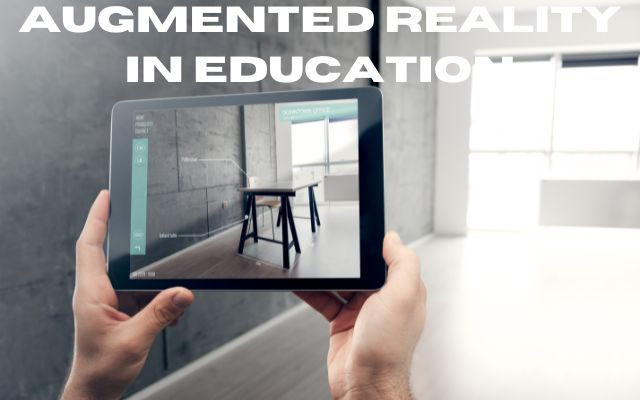How to Use Augmented Reality in Education: A Guide for Teachers

How to Use Augmented Reality in Education- Augmented reality (AR) is a technology that can bring a whole new dimension to the classroom. AR uses computer-generated images or video to overlay digital information in the real world. This means that students can interact with information in a way that was previously impossible. AR technology can be used in a variety of educational settings, from primary schools to universities. In this article, we will discuss how teachers can use AR in the classroom to enhance learning.
Understanding Augmented Reality
Augmented Reality (AR) is a technology that superimposes digital information – such as images, sounds, and text – onto the real world. Unlike Virtual Reality (VR) which creates a completely virtual environment, AR enhances the real world with virtual elements, creating a mixed reality. This makes AR more accessible as it can be used with smartphones and tablets, devices that most students already have.
The concept of AR has been around for decades, but it wasn’t until the 21st century that it started to become mainstream. The term “Augmented Reality” was coined by Tom Caudell, a researcher at Boeing, in the early 1990s. However, the first functional AR systems were developed in the late 1960s and early 1970s. These early systems were large, expensive, and impractical for general use.
Over the years, advancements in technology have made AR more affordable and widely available. Today, AR is used in various fields such as gaming, healthcare, military, and of course, education. Popular AR apps like Pokemon Go and Snapchat filters have brought AR to the masses, demonstrating its potential to create engaging and interactive experiences.
In the context of education, AR offers a unique opportunity to make learning more immersive and interactive. It allows students to visualize complex concepts, explore different scenarios, and engage with the subject matter in a more meaningful way. For example, in a geography lesson, students can use AR to explore different countries and landmarks. In a biology lesson, they can use AR to interact with 3D models of cells and organs.
Benefits of Using Augmented Reality in Education
Augmented Reality (AR) is more than just a technological novelty; it’s a powerful educational tool with numerous benefits that can transform the learning experience. Here are some key advantages of using AR in education:
1. Enhanced Engagement and Interactivity: AR makes learning more interactive, which can increase student engagement. Instead of passively reading or listening, students can interact with virtual objects, making learning more hands-on and enjoyable.
2. Improved Visualization and Understanding: AR can help students visualize complex concepts that are difficult to explain with traditional teaching methods. For example, in a biology lesson, students can use AR to explore a 3D model of the human body, enhancing their understanding of human anatomy.
3. Real-World Application and Practical Learning: AR can provide students with practical learning experiences. For instance, in a physics lesson, students can use AR to conduct virtual experiments, allowing them to apply theoretical knowledge to real-world scenarios.
4. Personalized Learning: AR can cater to different learning styles and paces. Students can explore AR content at their own pace, and teachers can tailor AR experiences to meet individual learning needs.
5. Increased Motivation: The novelty and interactivity of AR can motivate students to learn. AR can turn learning into a fun and exciting experience, which can boost students’ motivation and enthusiasm for learning.
Examples of Augmented Reality in Education
Augmented Reality (AR) is not a futuristic concept; it’s already being used in classrooms around the world. Here are some examples of how AR is transforming education:
1. Science Lessons: AR can bring science to life by allowing students to interact with 3D models of atoms, molecules, cells, and more. For example, the AR app “Elements 4D” lets students combine different elements to see chemical reactions in real-time.
2. History Lessons: AR can transport students back in time or take them to far-off places. For instance, the “Google Expeditions” app allows students to explore historical sites, landmarks, and even outer space.
3. Geography Lessons: AR can make geography more interactive and engaging. Apps like “GeoGebra AR” enable students to explore 3D models of geographical features and landmarks.
4. Art Lessons: AR can enhance creativity and artistic expression. For example, the “Quiver” app brings students’ drawings to life, adding a new dimension to their artwork.
5. Language Learning: AR can provide immersive language learning experiences. Apps like “Mondly” use AR to create realistic scenarios for practicing new languages.
6. Special Education: AR can provide tailored learning experiences for students with special needs. For example, the “Proloquo2Go” app uses AR to help students with speech difficulties communicate more effectively.
These examples illustrate the versatility of AR in education. Whether it’s making complex scientific concepts more understandable, bringing history to life, or providing personalized learning experiences, AR has the potential to revolutionize education.
How to Implement Augmented Reality in the Classroom
Implementing Augmented Reality (AR) in the classroom may seem daunting, but with the right approach, it can be a smooth and rewarding process. Here are some steps to guide you:
1. Understand the Technology: Before you can effectively use AR in your classroom, you need to understand what it is and how it works. Spend some time researching AR, experimenting with different AR apps, and familiarizing yourself with the technology.
2. Identify Learning Objectives: Consider your curriculum and identify areas where AR could enhance learning. Whether it’s visualizing complex scientific concepts, exploring historical sites, or practicing language skills, AR can be used in a variety of ways to support your learning objectives.
3. Choose the Right AR Tools: There are numerous AR apps and tools available for education. Some are subject-specific, while others are more general. Choose the ones that best align with your learning objectives and are easy for your students to use.
4. Create AR Content: Some AR tools allow you to create your own AR content. This could be as simple as creating AR flashcards, or as complex as designing a full-fledged AR lesson. Creating your own AR content allows you to tailor the learning experience to your students’ needs.
5. Integrate AR into Your Lessons: Once you have your AR tools and content, you can start integrating them into your lessons. This could involve using AR as a teaching aid, setting up AR stations for self-guided learning, or assigning AR-based homework.
6. Provide Training and Support: Remember, AR is likely new to your students as well. Provide training and support to help them navigate the AR tools and understand how to interact with the AR content.
7. Evaluate and Adjust: As with any new teaching method, it’s important to evaluate its effectiveness and make adjustments as needed. Gather feedback from your students, observe their engagement and progress, and adjust your use of AR accordingly.
Implementing AR in your classroom is an ongoing process of learning, experimenting, and adjusting. But with patience and persistence, you can harness the power of AR to create a more engaging and effective learning experience for your students.
Challenges and Considerations in Using Augmented Reality
While Augmented Reality (AR) offers numerous benefits for education, it also presents several challenges that educators need to consider:
1. Cost: AR technology can be expensive. Schools may need to invest in hardware, software, and training to effectively implement AR in the classroom.
2. Technical Issues: Like any technology, AR can have technical glitches. These can disrupt the learning process and cause frustration for both teachers and students.
3. Training: Teachers need to be trained to use AR effectively. This requires time and resources, which can be a challenge for some schools.
4. Accessibility: Not all students have access to the devices needed to use AR. Schools need to ensure that all students can participate in AR activities.
5. Distraction: While AR can make learning more engaging, it can also be distracting. Teachers need to manage this to ensure that AR enhances learning rather than detracts from it.
Despite these challenges, the potential benefits of AR in education make it worth considering. With careful planning and implementation, schools can overcome these hurdles and harness the power of AR to enhance teaching and learning.
The Future of Augmented Reality in Education
The future of Augmented Reality (AR) in education is promising and full of possibilities. As technology continues to evolve, we can expect AR to become an increasingly common tool in classrooms around the world.
One of the most exciting prospects is the potential for fully immersive AR classrooms. These would allow students to explore different environments, conduct virtual experiments, and interact with 3D models, all from the comfort of their classroom.
Moreover, as AR becomes more accessible and affordable, we can expect to see more educational institutions adopting this technology. This will not only enhance the learning experience but also help prepare students for a future where AR is likely to be a part of many professions.
However, the successful integration of AR in education will require ongoing research, investment, and training. Educators will need to keep up with the latest developments in AR technology and learn how to incorporate it effectively into their teaching.
Applications of Augmented Reality in Education
The applications of Augmented Reality in Education are transforming the way we teach and learn. Here are some examples:
- Interactive Learning Materials: One of the applications of augmented reality in education is the transformation of traditional textbooks into interactive 3D models, enhancing understanding and retention of complex concepts.
- Virtual Field Trips: AR can take students on virtual field trips, allowing them to explore historical sites, geographical landmarks, or even outer space from their classrooms.
- Practical Training: AR provides realistic simulations for practical training in subjects like medicine, engineering, or chemistry, allowing students to practice skills in a safe environment.
- Language Learning: Another application of augmented reality in education is immersive language learning experiences, helping students to practice new languages in realistic scenarios.
- Special Education: AR can be tailored to meet the needs of students with learning disabilities, providing them with engaging, accessible learning experiences.
- Gamified Learning: AR can turn learning into a fun, game-like experience, increasing student engagement and motivation.
While AR offers exciting possibilities, its effective implementation in education requires careful planning, appropriate resources, and ongoing evaluation. As technology continues to evolve, the applications of augmented reality in education are expected to expand, offering even more opportunities for innovative teaching and learning. 📚
- How to Use Virtual Reality in Business: A Guide for Companies
- How To Run A Healthcare Business In The Metaverse World
- These Are the Upcoming Trends for Online Gaming in 2023
Conclusion
In conclusion, Augmented Reality (AR) is a powerful tool that has the potential to revolutionize education. By making learning more interactive, engaging, and effective, AR can enhance the educational experience for students of all ages and abilities.
While there are challenges to overcome, the benefits of AR in education make it worth the effort. As we look to the future, we can expect AR to become an increasingly common feature in classrooms around the world. So, let’s embrace this exciting technology and explore the possibilities it offers for teaching and learning.
Frequently Asked Questions (FAQs)
1. What is Augmented Reality (AR)?
Augmented Reality (AR) is a technology that overlays digital information, such as images, sounds, and text, onto the real world. Unlike Virtual Reality (VR) that creates a completely virtual environment, AR enhances the real world with virtual elements.
2. How is AR used in education?
AR is used in education to make learning more interactive, engaging, and effective. It allows students to visualize complex concepts, explore different scenarios, and engage with the subject matter in a more meaningful way.
3. What are the benefits of using AR in education?
AR enhances engagement and interactivity, improves visualization and understanding, provides real-world application and practical learning, supports personalized learning, and increases motivation.
4. Can you give examples of how AR is used in education?
AR is used in various subjects. In science, students can interact with 3D models of atoms and molecules. In history, they can virtually visit ancient civilizations. In geography, they can explore different countries and landmarks. In art, they can see their drawings come to life.
5. How can teachers implement AR in their classrooms?
Teachers can implement AR in their classrooms by understanding the technology, identifying learning objectives, choosing the right AR tools, creating AR content, integrating AR into their lessons, providing training and support, and evaluating and adjusting their use of AR.
6. What are the challenges of using AR in education?
The challenges of using AR in education include cost, technical issues, training, accessibility, and potential distraction.
7. What is the future of AR in education?
The future of AR in education is promising. As technology continues to evolve, we can expect AR to become an increasingly common tool in classrooms around the world. The potential for fully immersive AR classrooms and more accessible and affordable AR tools are some of the exciting prospects.
8. How can I optimize my AR content for SEO?
To optimize your AR content for SEO, ensure that the keyword “Augmented Reality” is used naturally throughout the text. Include internal and external links, meta descriptions, and alt text for images to improve its search engine visibility.






